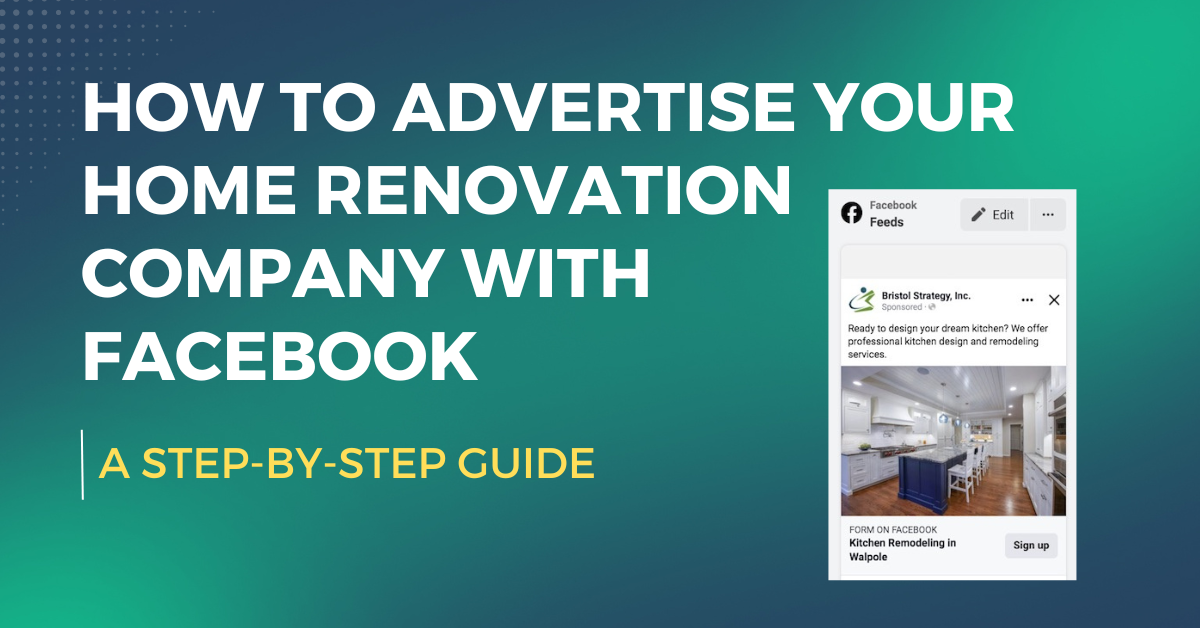
Today’s world is a digital one — which means you’ve likely thought about advertising your home renovation business online but wondered about how to get started.
Two of the biggest online advertising players that come to mind are, of course, Google Ads (formerly known as Adwords) and Facebook Ads. Each of these platforms has its own strengths; however, for this post, we’re going to focus on Facebook Ads for a few reasons: its highly detailed audience targeting, ability to drive awareness of your brand, it is a better fit for B2C businesses and emphasis on visuals (perfect for a home renovation business such as yours).
Because this is a long article that is chock-full of insights, we're providing a linked index here so you can read just what you are interested in.
Let's first talk about why advertising can be beneficial for your business, specifically in relation to generating leads through your website. In this case study, we outline how a landscape business was able to completely revamp its operations with the help of a successful inbound marketing campaign that led to a substantial increase in qualified leads and sales. By making the necessary investments, the business was able to attract a steady stream of leads that continued to grow naturally over time.
When a business chooses an advertising strategy to drive traffic and leads, they are by default understanding that the growth of their business is "coin operated," which means that once they stop advertising, the leads also stop. Our recommendation for any home renovation business is to invest in building a long-term, sustainable lead generation strategy and use advertising to step on the gas when more business is needed.
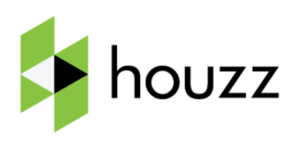 Before we drill into Facebook ads, let's briefly talk about niche social and review networks like Houzz, Angi (formerly Angie's List), and Yelp. These three networks have been used by many home renovation companies (and other local businesses) as the default platform for sharing examples of their work. These platforms also offer advertising to business owners.
Before we drill into Facebook ads, let's briefly talk about niche social and review networks like Houzz, Angi (formerly Angie's List), and Yelp. These three networks have been used by many home renovation companies (and other local businesses) as the default platform for sharing examples of their work. These platforms also offer advertising to business owners.
The most important advice I give home remodeling business owners when choosing to invest money to advertise in these networks is to use campaign links that enable your business to track the financial return on these and every advertisement you run. Here is a Google page about campaign links.
Don't just link to your home page with a normal link. Link to a unique landing page for each network with a clear call to action for the visitors. Install analytics on your website so you can track a lead all the way to a call with your sales rep while identifying the source for each individual contact.
As a home renovation business leader, you may ask: why not advertise on LinkedIn? While we always recommend clients create a LinkedIn page for their business and to post articles and other business updates on LinkedIn, we do not suggest advertising on LinkedIn because the cost per lead is very high. LinkedIn is a great platform for B2B businesses, but not so much for B2C businesses like a home renovation company. Of course, there are always exceptions to the rule, especially if you have a significant business clientele where your advertisement is very targeted to the right titles in your local area.
If you have had success advertising a home renovation business on LinkedIn, please add a comment so we can discuss your results!
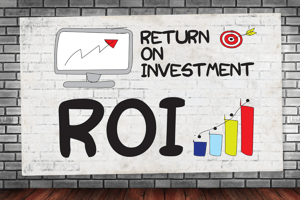 At the end of each month, analyze the ROI of your advertising investment by dividing the project profit by the advertising investment ROI = (Home Renovation Service Profit / Advertising investment).
At the end of each month, analyze the ROI of your advertising investment by dividing the project profit by the advertising investment ROI = (Home Renovation Service Profit / Advertising investment).
If the profit comes from a recurring home renovation service, like home maintenance services, then for the home renovation profit, use the profit for the entirety of the service term as the value in the numerator. You want a positive number for ROI, not a fraction. An ROI of 1 means it cost you as much to run the advertisement as the profit you earned. Here is a page that shows the ROI calculation.
The reason I suggest measuring the ROI is because I see many home renovation businesses (and other B2C businesses) wasting money on advertising that does not generate positive results.
Facebook offers you a number of different ad options for you to choose from, depending on your goals. For this tutorial, we are going to create a lead ad, which can be a powerful technique for growing your business via inbound marketing.
Lead ads allow you to capture a prospective client's contact information directly within the Facebook platform; when a lead converts, Facebook sends that lead to you. In addition, the conversion rate of lead ads is generally higher than ads that redirect to a landing page on a website.
To help guide you in creating your first Facebook lead ad, we're going to create a fictional Facebook lead ad for a kitchen remodel campaign using this helpful, step-by-step tutorial.
Navigate to the Facebook ads manager at business.facebook.com. If you have not yet created a Facebook Ads account, you can find instructions on how to do so here.
Once you’re in your account, select All Tools > Ads Manager.
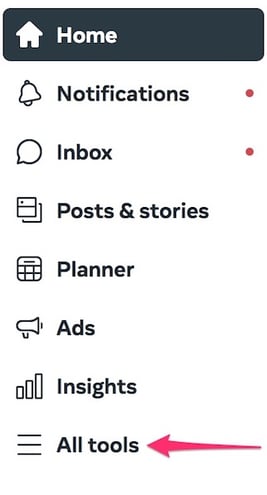
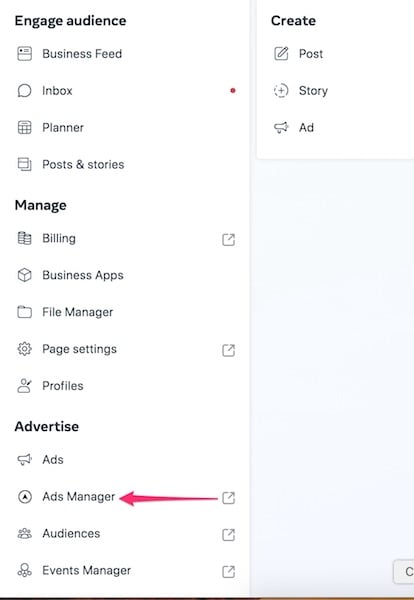
Once you're in your ad account, select Create. 
Depending on the results you would like to achieve with your ad campaign, Facebook offers a number of different ad goals you can choose from:
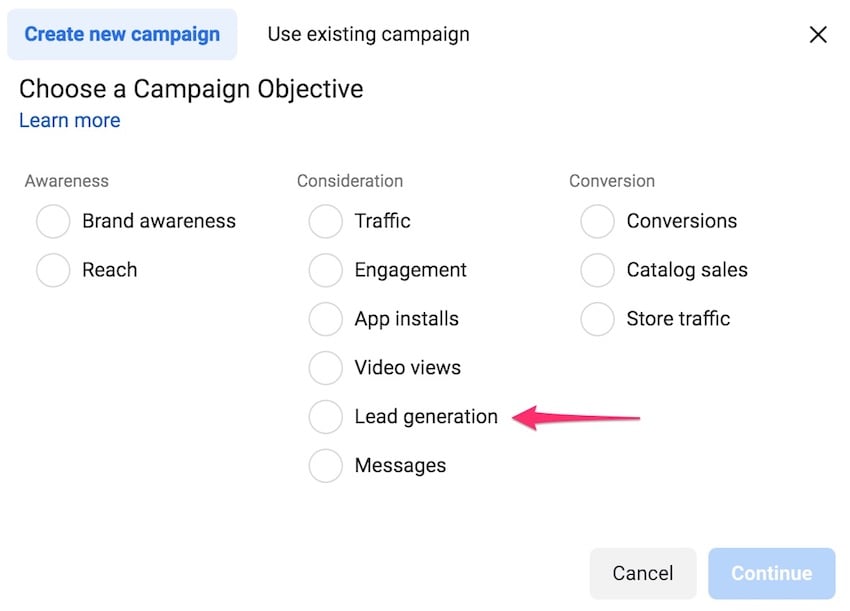
When a person clicks on a lead generation ad (also called a lead ad), Facebook provides them with a form and automatically populates it with the information you are asking for from the user. When a user completes the action, the information is sent to you.
You'll see that each of these campaign objectives falls under one of three categories: awareness, consideration, or conversion. These are also known as the stages of the buyer's journey, which is the process a prospective customer uses to decide if they would like to purchase your product or service.
Next, you’ll want to name your campaign. It’s important to choose your campaign, ad set, and ad names thoughtfully, as a well-organized approach to naming can be extremely helpful in reviewing your campaign analytics, understanding which ads are performing best, and calculating ROI.
Because the ads we are creating are lead generation ads, we’ll include a similar term (lead gen) in the ad campaign name.
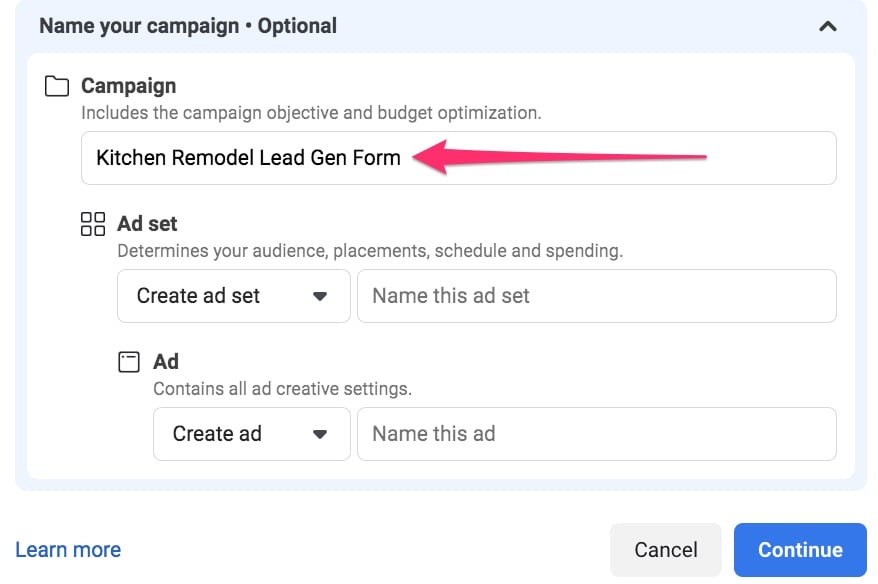
Next, you'll be prompted to name your ad set, which is a group of ads that share a budget, audience, campaign schedule, bidding, and placement.
For our kitchen remodel campaign, we've decided we want to create different ad sets targeting prospective clients in different towns. This particular ad set will target individuals who live in Walpole (Bristol Strategy's hometown).
But location isn't the only criterion we want to use to target our ads. We'd also like to break down our ads by gender, and age range, to see if there is a difference in how these audiences perform. So, this ad set will target women aged 30 to 45 who live in Walpole, and we've named it accordingly.
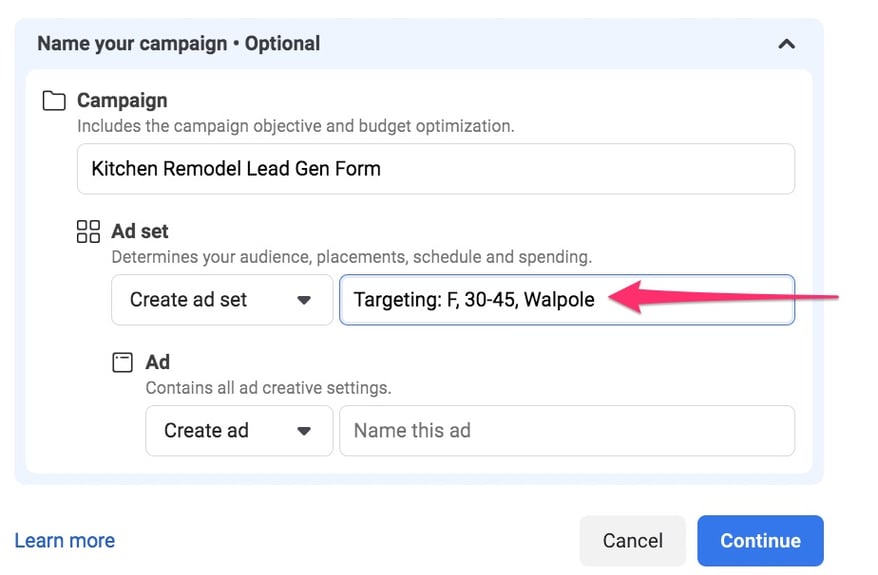
Now, you need to name your ad. To help us keep track and stay organized, the ad name will include the campaign and audience information we already defined. This ad will use a photo of a kitchen island, so we'll also include that information in the ad name to help us easily differentiate between multiple ads.
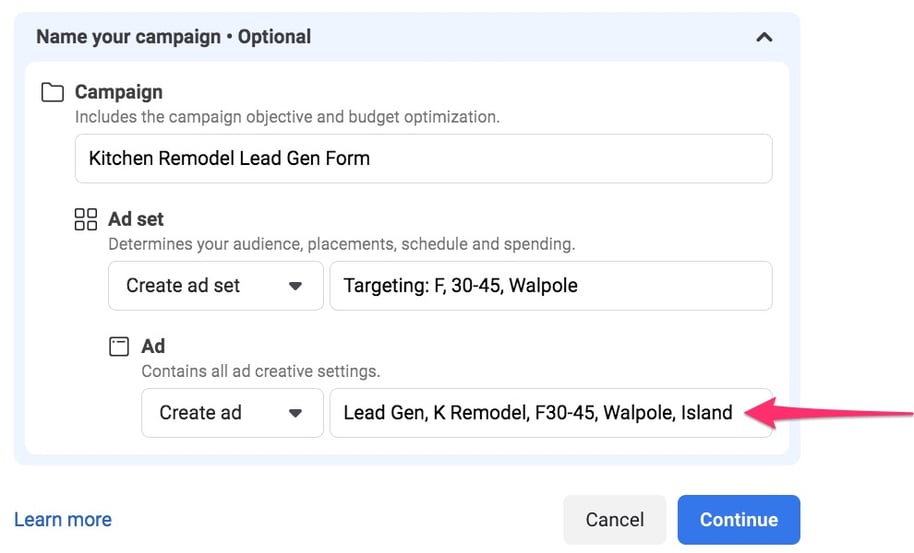
Now, it's time to think about our ad budget. You have a few different options for how to spend money on your campaign. With both of these options, you can select either a daily or lifetime budget (a lifetime budget is the maximum amount you will spend).
First, you can choose campaign budget optimization. With this approach, Facebook will spread the costs across all of the ad sets in the campaign, optimizing for the ones that perform the best over time. (Remember, in this tutorial, our campaign is Kitchen Remodel Lead Gen Form).
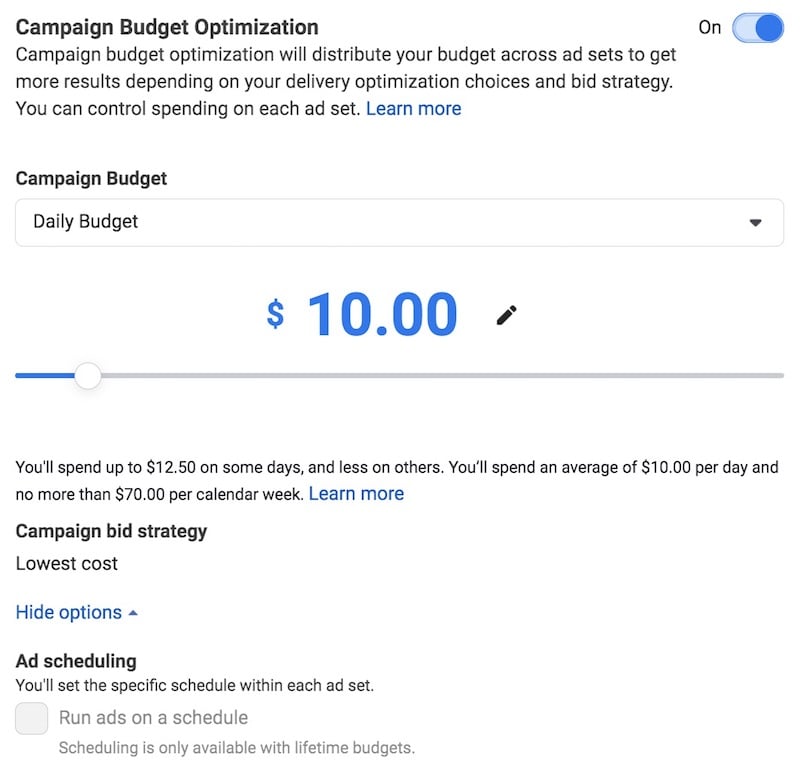
With campaign budget optimization, you can set a schedule for your ads only if you choose the lifetime budget option.
Another way to organize your budget is by ad set. (As a reminder, the ad set we created earlier is Targeting: F, 30-45, Walpole). This means you determine your costs for each group of ads rather than the entire campaign as a whole.
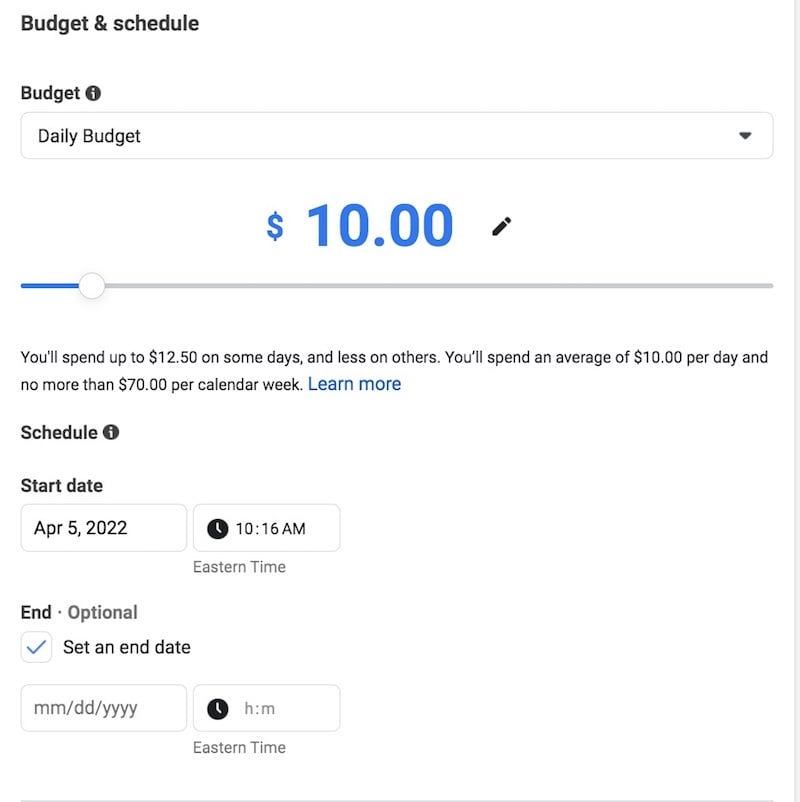
You can choose to have your ads run continuously, or you can specify an end date.
As you progress through the budgeting process, you'll see the option to set a campaign budget before you have the option to choose an ad set budget instead. If you'd like to set your budget by ad set, simply toggle the campaign budget optimization option to off.

Using its detailed demographic information, Facebook allows you to target your ads so that they display only to a very specific audience. This is how we are able to create an ad that reaches only women who may be homeowners in a specific age range and location, as we are doing in this example.
And speaking of location targeting, one of the most important ways you’ll likely target your ads as a home renovation company is to restrict them to audiences in specific zip codes, a practice known as geofencing. These zip codes correspond with your business service area and ensure that your ads are seen by the people you most likely want to serve.
To continue with our ad creation process, we'll start by adding the audience information we outlined above: location, age, and gender.
Because we've chosen to target this ad set to an audience in a single town, we've selected only a single zip code for the location. However, Facebook also gives you the option to target multiple zip codes or a specific radius. In addition, because we're promoting a service targeted to people who are likely to be homeowners, it's important to select "People who live in this location" from the dropdown.
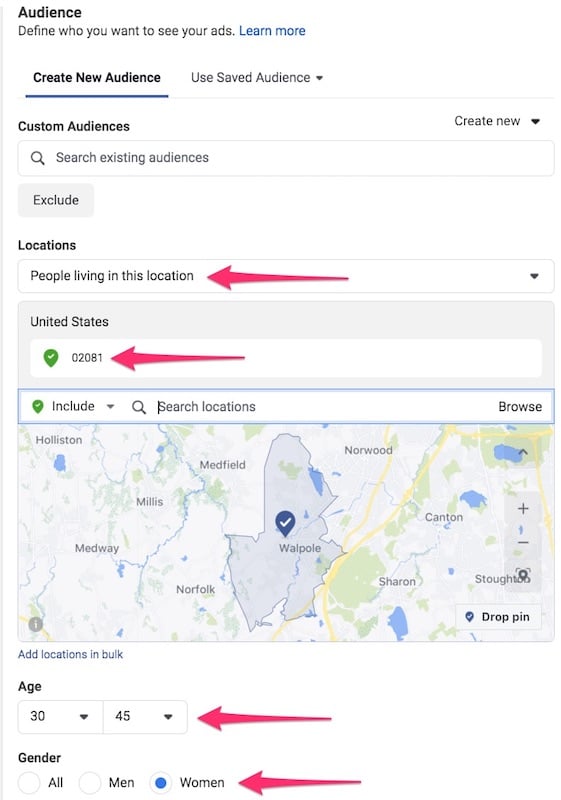
In addition, with these ads, we'd like to reach new prospective clients who are unfamiliar with our home renovation business, so we're going to choose to exclude users who already like our business's Facebook page.
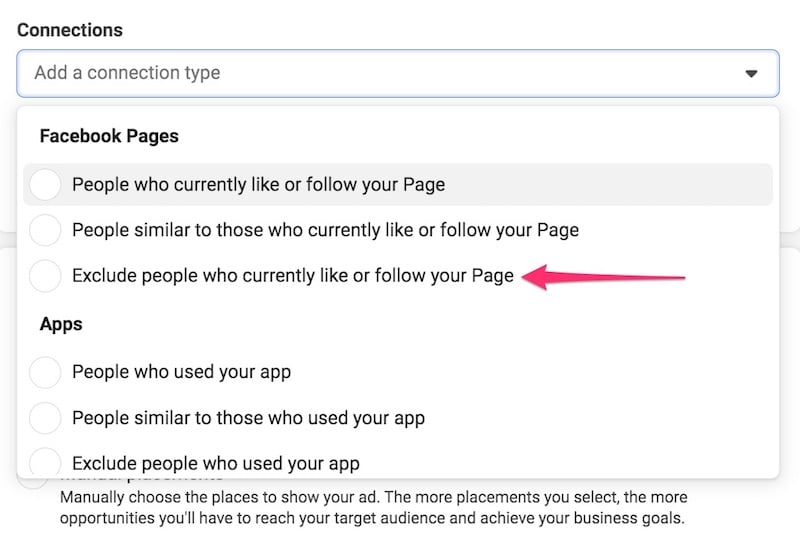
Keep in mind that if your audience is too narrow, your targeting may be too specific for your ads to be effective. Facebook will prompt you if this may be an issue.
Your next step is to choose what you'd like your ad to look like. We're going to use the single-image format.
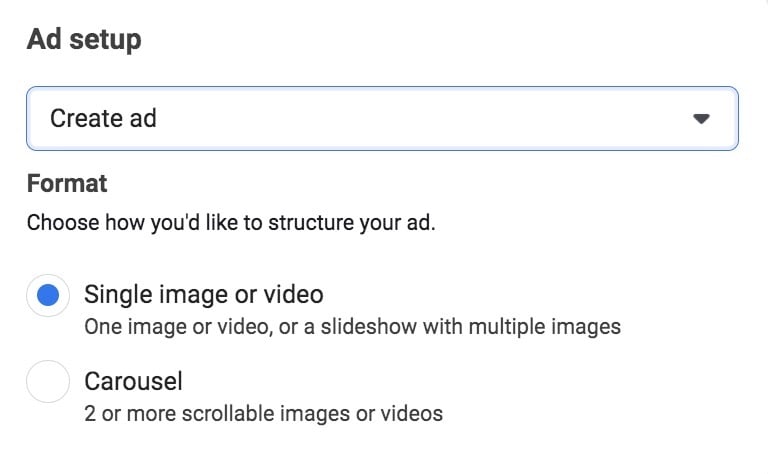
When creating your ads, it’s critical that you have clear, compelling imagery, as this is what will capture a prospective client's attention. In the home renovation industry, examples of your own home renovation work lend themselves extremely well to the types of visuals that make great ads.
Make a habit of taking high-quality photos of both your work and your team before, during, and after projects while on the job site. You’ll want a lot of image options available when creating your ads, so take photos and video from a number of angles and varying orientations (horizontal and vertical). For a business like yours, you may even want to hire a professional photographer to take photos of some projects.
As a home renovation business, you likely offer clients a variety of different services, such as kitchen and bathroom remodeling or home additions. With such wide-ranging expertise, you’d certainly want to create ads that show clients everything you can do for them, right?
Resist the temptation to create a broad topic ad. Instead, each ad should have a singular focus.
Even though your prospective clients may have a need for multiple services eventually, they’re not looking to solve all of their problems at once—they’re interested in solving one, whether that is, "How can I remodel my kitchen to make it more functional?" or "Can I add another bathroom to my house?
Prove to each prospective client that you’re the perfect option for them. If you try talking to everyone at once, you risk that you’ll end up connecting with no one.
There are multiple components to designing your ad. You'll start with selecting an image. As you make changes to each of your ad's creative elements, you'll be able to preview what they'll look like in a variety of Facebook ad placement options, such as news feeds and stories.
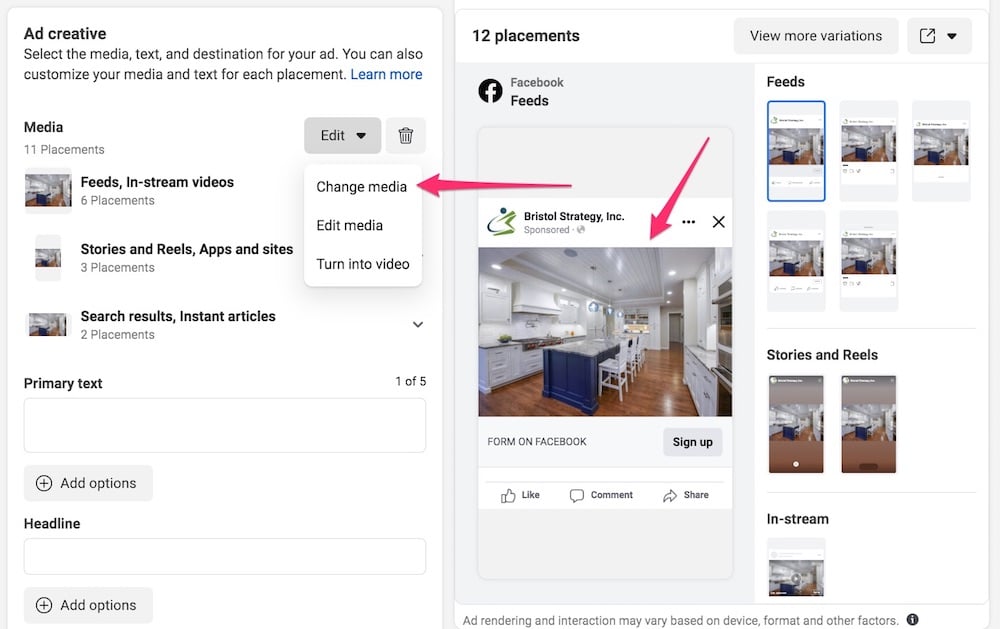
Once that's completed, you can create the additional ad elements. Note how we added the target audience's location (Walpole) to the headline to help better attract their attention. Make sure each aspect of the ad makes sense for the specific service you want to promote.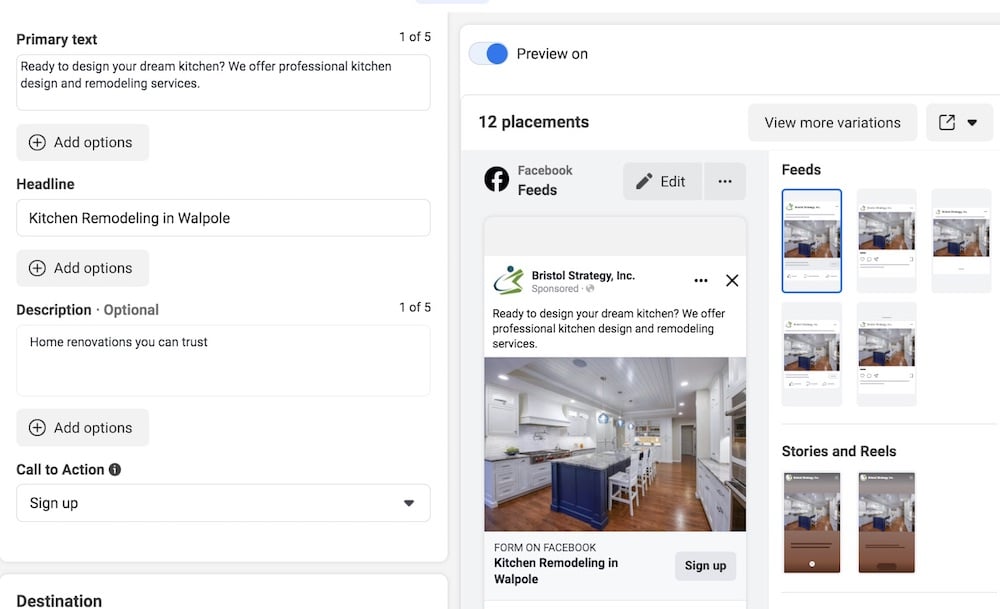
Because the objective of this ad campaign is to generate new contacts for our business through Facebook, we also need to create a form to capture these leads. You have options to customize the types of information you gather. Go to Instant form > Create form.
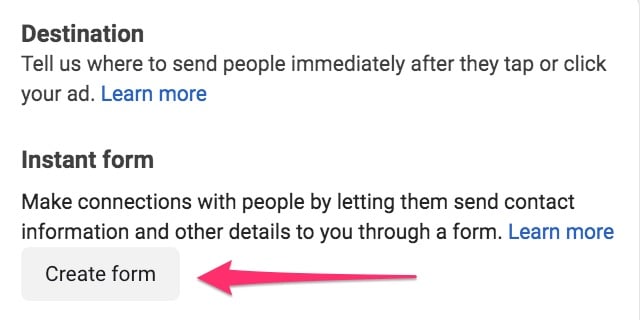
Then, you'll input your form name. Use a clear, consistent naming structure, just as you did when you created your campaign, ad set, and ad.
After that, you'll choose your form type. A form optimized for more volume allows users to quickly submit their information, which can lead to a larger number of leads. A higher intent form has a few additional features, such as a review screen, that can help qualify leads further, potentially eliminating those who may be less strongly interested in your business. We're going to choose the more volume form type, so our prospective customers can submit their information as easily as possible.
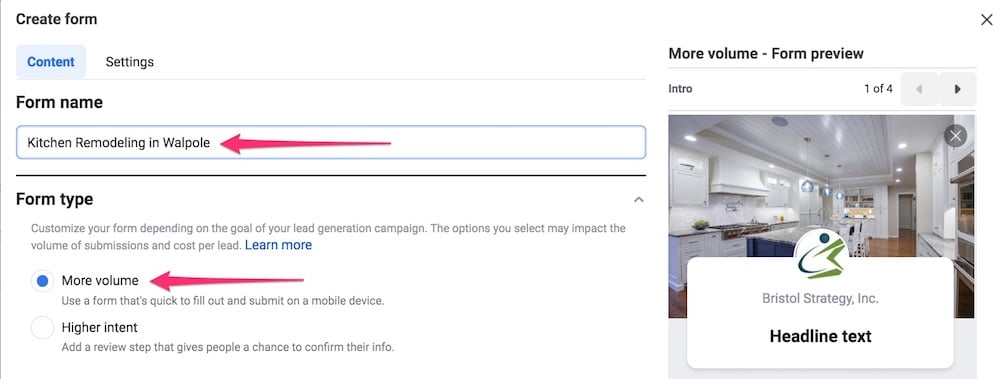
Now, you'll choose your form's background image, greeting, and description.
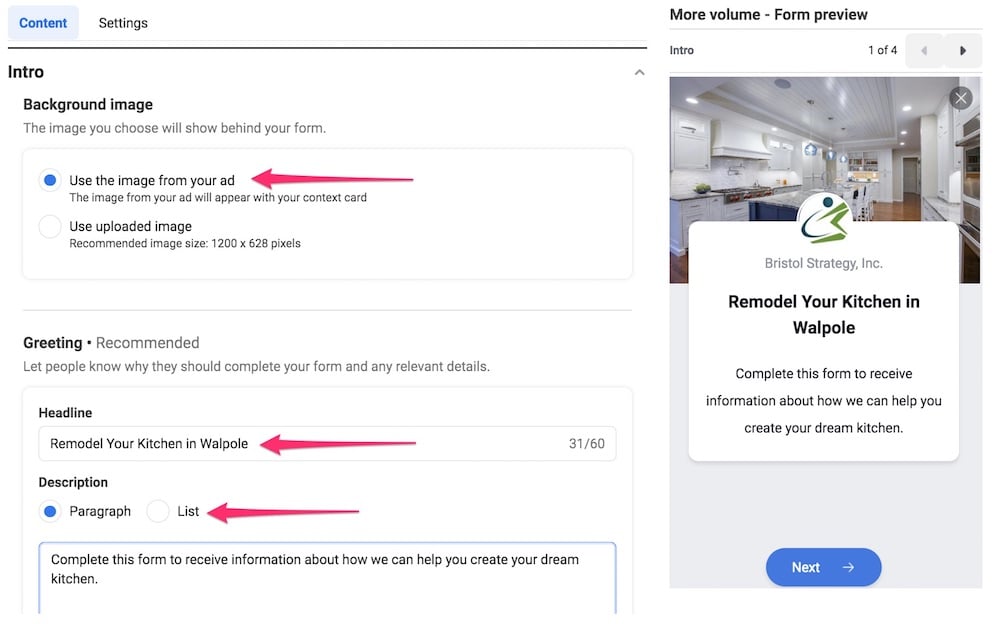
From there, you'll choose the information about prospective customers you'd like to collect from this form. Facebook offers a list of questions, such as name, email, and street address, that will be pre-populated with information from the user's Facebook account. In addition, you can also create custom questions if there is additional information you want to capture.
Keep in mind the more fields you require a user to complete, the less likely they are to finish the form and convert as a lead, so don't ask more questions than necessary to achieve your goal.
In this section, you'll also need to tell users how you'll use their personal information once they submit it to you. This message should be clear and concise. Once you have obtained a prospective customer's information, you can use it only for the purpose you state here.
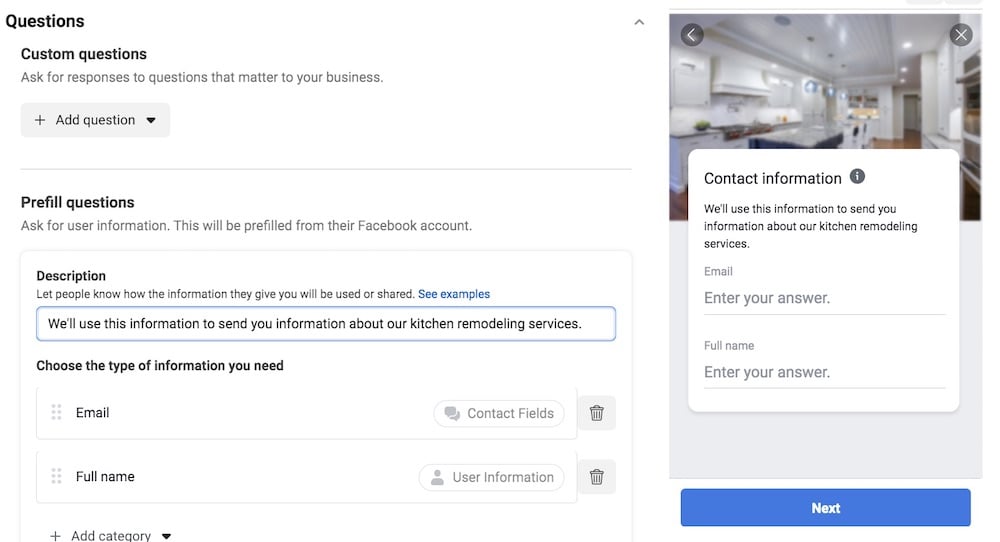
To protect users' privacy, Facebook also requires that you include a link to a privacy policy.
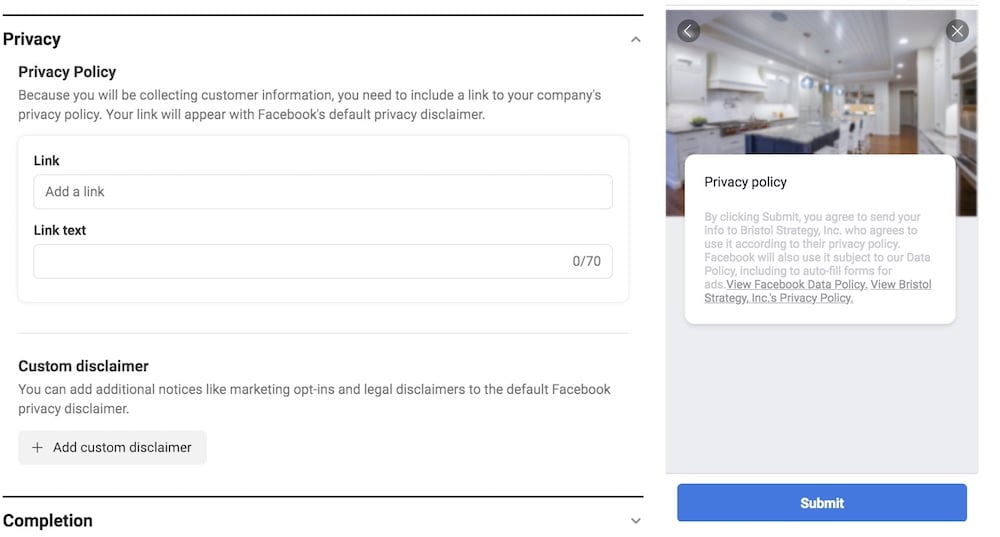
Finally, you can customize the message the prospective client receives once they've submitted the form.
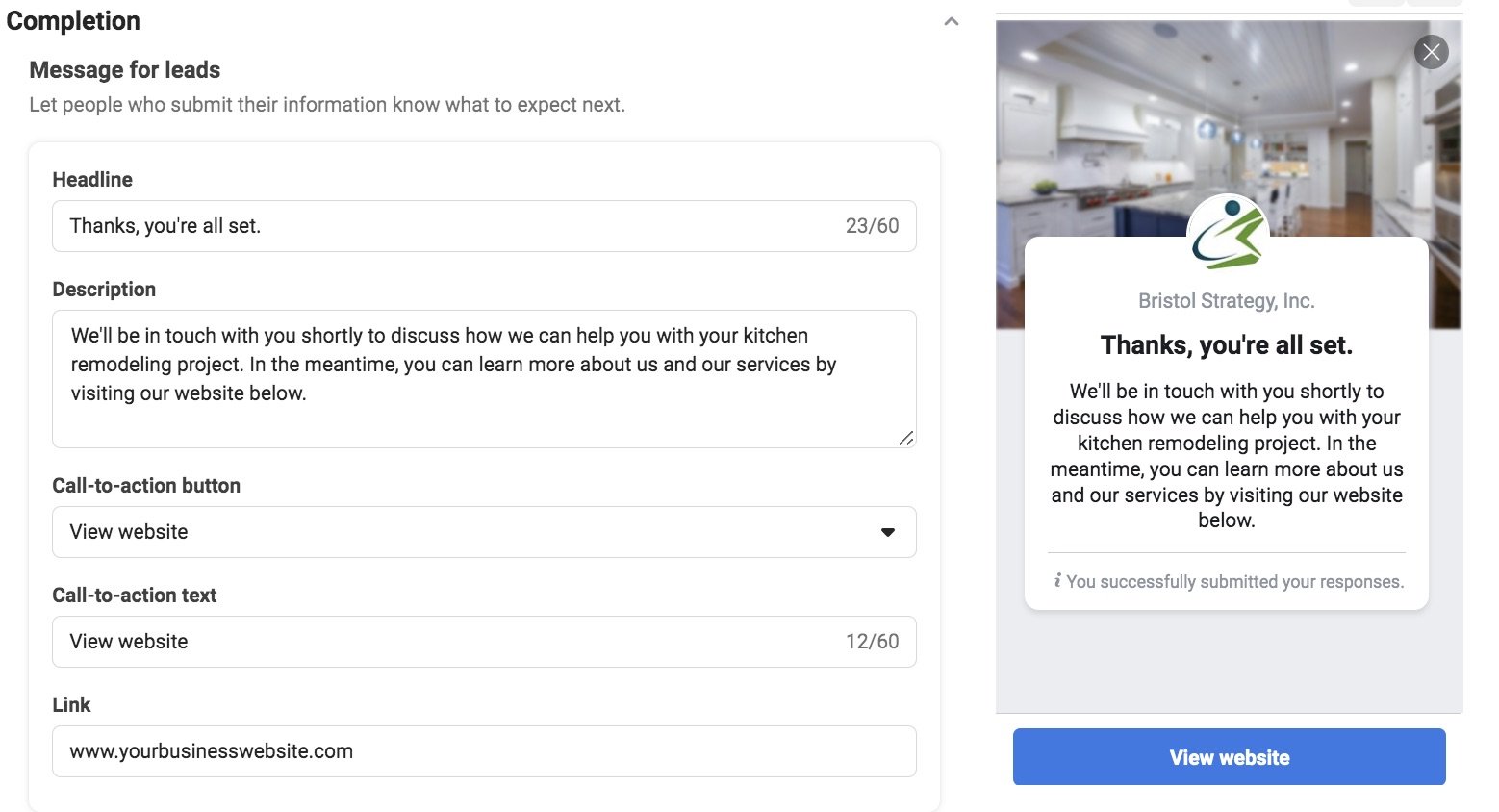
When you create your ad, you also can enable the Meta Pixel, which helps you measure how effective your ad campaigns are by tracking visitors' actions on your website. While Meta Pixel is not required to run ad campaigns, it is best practice to do so. You can get more information about Meta Pixel and instructions on how to set it up here.
![]()
Now that your ads are up and running and leads are coming in, what exactly should you do with them? We recommend that you integrate your lead ads campaign with a marketing automation platform, which is a key component of any inbound marketing strategy.
At Bristol Strategy, we use HubSpot for marketing automation. HubSpot's free Marketing Hub package allows you to move new leads directly from Facebook to the HubSpot dashboard, where you can begin integrating those new contacts into your inbound marketing campaigns. We have several B2C clients who are using the free Hubspot Facebook Lead Ads integration to capture leads and manage their follow-up and pipeline. Reach out to us, and we will help you get started.
You’ve created your ad, it’s started running, and you’re getting some traffic and even new leads. That’s great! But you’re not done yet.
It’s a mistake to create an ad and simply run it forever, even if it is generating an ROI for you. That’s because slight tweaks to the ad could generate even better results for you—but you won’t know until you test them.
During your campaign, you should run multiple versions of the same ad at the same time, with the goal of testing them to see which version performs best. Some ideas for ad elements you can test:
When you A/B test your ads, you should change only one single element at a time—for example, test the headline by only changing the headline text, but leave everything else the same between the two ads. The reason for this best practice is that if you test multiple elements of the ad at once, you won’t be able to isolate exactly which aspect is causing one ad to perform better than another.
Be sure to review your ad campaign regularly, so you can quickly remove ads that are not performing well and implement further testing against the ones that are.
When developing your ad campaigns, it’s critical that you remember this: Your ultimate goal isn’t to get more traffic to your website. It’s to get more clients and revenue for your business.
For that reason, your campaign must include opportunities for measuring your results. Even if you get many clicks on your ads, if none of those visitors actually convert into clients, your campaign really hasn’t been successful.
To make sure you’re getting the right results, you’ll want to calculate the cost to acquire new clients all the way through to conversion. These conversion goals could include actions such as scheduling a phone call, setting up a meeting, or downloading a free ebook.
Online advertising platforms such as Facebook offer an incredibly powerful way to connect with prospective clients who may not already be aware of your business. Paid ads provide you with an immediate opportunity to drive traffic and leads while you execute on another method of building traffic, particularly organic: implementing an inbound marketing strategy that is the core to creating an inbound marketing sales funnel, as discussed previously.
With an inbound marketing strategy, you’ll make an upfront investment in creating valuable, educational content that can drive traffic to your website and generate new leads for free for years afterward. In fact, we believe it's the best way to grow your business. See how we helped other businesses like yours by reading this case study.
Interested in chatting more about how online advertising campaigns, such as on Facebook, can complement an inbound marketing strategy? Book a one-on-one call now to discuss it.
Bristol Strategy is a full funnel inbound marketing agency and inbound sales agency offering the full complement of services to enable our clients to surpass their business objectives by transforming the way they engage with their buyers online. Reach out to us to learn more about how our experience and capabilities can help your business grow.
Ask us about our unique approach that creates a full-funnel "inbound" engagement model for your business that attracts and converts digitally engaged prospects.